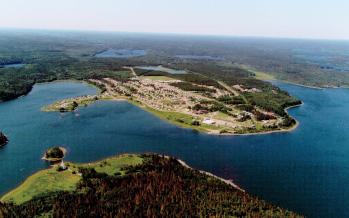
Is located 80 km NE of La Ronge on the Churchill River. Although in an area long-frequented by the region’s indigenous people, the settlement of Stanley Mission began with the arrival of the Anglican Church. The Missionary Society of the church had already established a presence in Africa and South America when it started building missions in Rupert’s Land in 1822. The primary goal was to convert aboriginal people to Christianity, but the Society also wanted to develop small, self-sufficient agricultural communities that would use hunting and fishing to supplement the food produced. In 1845, the Hudson’s Bay Company granted permission to the Anglican Church to establish a mission in what was then known as the English River (now Churchill) district. Reverend Robert Hunt arrived at Lac la Ronge in 1850 and in 1851 chose a site on the north side of the Churchill River for the mission. The first buildings erected were the parsonage and a schoolhouse, followed by a warehouse, a storeroom, barn, icehouse, and a carpenter’s shop. Between 1854 and 1860 Reverend Hunt oversaw the construction of the magnificent Holy Trinity Anglican Church, now the oldest building standing in Saskatchewan. The lumber was cut locally; however, the locks, hinges, and the thousands of pieces of coloured glass which would comprise the stained glass windows came from England. The name Stanley Mission honours Reverend Hunt’s ancestral home, Stanley Park, Gloucestershire, England. Although the Hudson’s Bay Company opened a trading post on the south side of the river in 1853, it was on the north side of the river, around the mission, that a thriving community developed. Through the 1860s and 1870s the farm land under cultivation was increased and a grist mill for grinding local wheat into flour was constructed. By the early 20th century, though, the situation at the mission was changing. The mission and residential school at La Ronge were gaining greater importance at the expense of Stanley Mission and by 1905 had replaced Stanley Mission as the Church headquarters in the district. Around 1919–20, an epidemic, perhaps influenza, perhaps smallpox, claimed, according to one source, about 30 lives. Then, in the 1920s, rival trading posts competing with the Hudson’s Bay Company on the south side of the river created additional activity in that area, and with the creation of First Nations reserves and the subsequent construction of houses, also on the south side, the population of Stanley Mission began to dwindle. By the early 1960s virtually all of the buildings were situated across the river from Holy Trinity Church. In 1978 an all-weather road was built from La Ronge and with it came all of the trappings of the modern age. Today, approximately 1,500 people live in the community: a small number on the point of land across the river from the church, which is technically the Northern Settlement of Stanley Mission; and the remainder, and bulk of the population, members of the Lac La Ronge Indian Band who live on the adjacent reserve. Holy Trinity Anglican Church is a Provincial Heritage Property, a National Historic Site, and is incorporated into Lac La Ronge Provincial Park. It is accessible only by water.
David McLennan
Print Entry|
HOME | BROWSE BY SUBJECT | ENTRY LIST (A-Z) | IMAGE INDEX | CONTRIBUTOR INDEX | ABOUT THE ENCYCLOPEDIA | SPONSORS TERMS OF USE | COPYRIGHT © 2006 CANADIAN PLAINS RESEARCH CENTER, UNIVERSITY OF REGINA | POWERED BY MERCURY CMS | |||
| This web site was produced with financial assistance provided by Western Economic Diversification Canada and the Government of Saskatchewan. | |||
 |
 |
 |
 |
| Ce site Web a été conçu grâce à l'aide financière de Diversification de l'économie de l'Ouest Canada et le gouvernement de la Saskatchewan. | |||